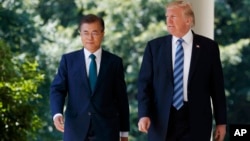South Korean President Moon Jae-in says his government has stepped up efforts to take back wartime operational control (OPCON) of its forces from the U.S.-led command structure, at a time when North Korea and the U.S. are both threatening war.
In an address to commemorate the nation’s 69th Armed Forces Day Thursday, President Moon said that by increasing defense capabilities and reducing its reliance on American military might, South Korea would project more power in the region and better deter a North Korean attack.
“When the South has wartime operational control, the North will fear us more, and our armed forces will be trusted more,” Moon said.
The liberal government in Seoul may also be trying to send a political message that it does not support U.S. President Donald Trump’s strong “fire and fury” rhetoric and threats to respond with overwhelming force to North Korean provocations.
“I think this might be a way for Moon to separate himself somewhat from the behavior of Donald Trump in the last month,” said Robert Kelly, a professor of political science at Pusan National University in South Korea.
Veto power
After becoming a democracy in the 1990s, the South Korean government assumed peacetime command of its 655,000 active military personnel.
The South Korean military coordinates closely with the Combined Forces Command and the United Nations Command led by U.S. General Vincent Brooks, who is also commander of the 28,500-plus member U.S. military force in Korea.
In wartime, the U.S. commander would assume control of South Korean forces as well, but it is not an automatic transfer of command. The South Korean president has to first agree to cede that control.
“In a way President Moon (already) has control and he has a veto over giving control to the U.S. and giving control to the combined forces command,” said regional security analyst Daniel Pinkston with Troy University in Seoul.
Divisive issue
Moon and other South Korean liberals have long advocated for wartime OPCON in large part as a sovereignty issue, and it is associated with anti-American sentiment in the country.
Conservatives have long opposed taking on independent wartime control, out of concern that it might weaken the U.S. commitment to help defend South Korea.
Hong Jun-pyo, the head of the Liberty Korea Party, recently said the “Return of OPCON is basically disbanding the Korea-US military alliance.”
And it could be seen by enemies and allies alike as a sign of growing friction between Seoul and Washington.
“This is what the North Koreans have wanted for a long time. Sort of drive the two of them apart. And they will be getting what they want, if this goes through,” Kelly said.
Defense spending
In 2014, Seoul and Washington decided to postpone the wartime OPCON transfer until at least 2020, but made the deal contingent on South Korea gaining the necessary operational capabilities.
Making the OPCON transfer decision based on capability can produce a positive outcome for the U.S.-South Korea alliance, as it puts the obligation on Seoul to take more responsibility for its own defense.
“If there is no discussion and no sense at all that there would ever be any kind OPCON transition, then there is kind of a moral hazard problem. South Korea will think we don’t have to worry about it because the U.S. will always have OPCON, they will always take care of us so why should we spend more on our defense budget,” Pinkston said.
To that end, President Moon is promising to implement reforms to create a more professional military, and to increase national defense spending to develop its own missile defense system, and launch five military satellites to provide needed intelligence, surveillance and reconnaissance capabilities.









